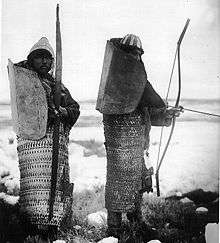Lamellar armour
Lamellar armour is a type of body armour, made from small rectangular plates (scales or lamellae) of iron or steel, leather (rawhide), or bronze laced into horizontal rows. Lamellar armor was used over a wide range of time periods in Central Asia, Eastern Asia (especially in China, Japan, Mongolia, and Tibet), Western Asia, and Eastern Europe. The earliest evidence for lamellar armor comes from sculpted artwork of the Neo-Assyrian Empire in the Near East.
Description

Lamellar armour consists of small platelets known as "lamellae" or "lames", which are punched and laced together, typically in horizontal rows. Lamellae can be made of metal, leather cuir bouilli, horn, stone, bone or more exotic substances. Metal lamellae may be lacquered to resist corrosion or for decoration. Unlike scale armour, which it resembles, lamellar armour is not attached to a cloth or leather backing (although it is typically worn over a padded undergarment).
In Asia, lamellar armor eventually overtook scale armour in popularity as lamellar restricted the user's movements much less than scale armour.[1]
Use and history

.jpg)
The earliest evidence points to the post-Iron Age Assyrians as the people responsible for the early development and spread of this form of armour, during the Neo-Assyrian Empire. In the numerous battle scenes depicted in the reliefs from Niniveh and Nimrud, commemorating the victories of Ashurnasirpal and Ashurbanipal from the 8th and 7th centuries BCE, hundreds of Assyrian soldiers, both infantry and cavalry are represented wearing cuirasses constructed of lamellae. These cuirasses reach from shoulder to waist, and in many instances they have short, close sleeves. If we accept the representations as correct and translate the method of construction literally, then we are confronted with a type of lamellar armour quite different from later specimens.[2]
Lamellar armour was often worn as augmentation to existing armour, such as over a mail hauberk. The lamellar cuirass was especially popular with the Rus, as well as Mongols, Turks, Avars, other steppe peoples, as well as migratory groups such as the Longobards as it was simple to create and maintain. Lamellar helmets were also employed by Migration Era and Early Medieval peoples.
Lamellar is pictured in many historical sources on Byzantine warriors, especially heavy cavalry. It is thought that it was worn to create a more deflective surface to the rider's armour, thus allowing blades to skim over, rather than strike and pierce. Recent studies by Timothy Dawson of the University of New England, Australia, suggest that Byzantine lamellar armour was significantly superior to mail armour.[3]
Lamellar armour has been found in Egypt in a 17th-century BCE context.[4] Sumerian and Ancient Egyptian bas-reliefs depicting soldiers have been argued as portraying the earliest examples of lamellar armour, particularly on chariot drivers, but it is not until the time of the Assyrians (circa 900–600 BCE) that possible examples of lamellar appear in the archaeological record. Among finds of Assyrian armour (often individual or unconnected scales), there are examples that can clearly be classified as scale armour as well as others that appear to be lamellar, and there exist a large number of finds whose function has proven difficult to determine.
The extent to which either type was used is a debated topic. Lamellar was used by various cultures from this time up through the 16th century. Lamellar armour is generally associated with the armour worn by the samurai class of feudal Japan. Lamellar armour is also associated with Mongolia, Eastern Russia, the tribes of Siberia and the Sarmatians. Evidence of lamellar armour has also been found in various European countries.[5]
Japanese lamellar armour
Lamellar armor reached Japan around the 5th century, predating the rise of the samurai caste.[5] Early Japanese lamellar armour, called keiko, took the form of a sleeveless jacket and a helmet.[6] The middle of the Heian period was when lamellar armour started to take the shape that would be associated with samurai armour. By the late Heian period Japanese lamellar armour developed into full-fledged samurai armour called Ō-yoroi.[7] Japanese lamellar armour was made from hundreds or even thousands of individual leather (rawhide) or iron scales or lamellae known as kozane, that were lacquered and laced together into armour strips. This was a very time-consuming process.[8] The two most common types of scales which made up the Japanese lamellar armour were hon kozane, which were constructed from narrow or small scales/lamellae, and hon iyozane, which were constructed from wider scales/lamellae.
See also
Related and similar armour types
- Mail and plate armour - An armour combining mail and lamellar-style metal plates in its construction (e.g. Indian armour).
- Scale armour - Armour constructed from hardened scale-shaped objects, similarly to lamellar armour.
- Laminar armour - An early form of plate armour used by ancient Romans.
Lamellar armour in Europe
Lamellar armour in East Asia
Lamellar armour in North Asia
Lamellar armour in Southeast Asia
References
- Oriental Armour, H. Russell Robinson, Publisher Courier Dover Publications, 2002, ISBN 0-486-41818-9, ISBN 978-0-486-41818-6 P.6-7
- H. Russell Robinson, Oriental Armour, Dover Publications, Inc., Mineola, New York, 2002.
- Dawson, Tim (1998). "Kremasmata, Kabadion, Klibanion: Some aspects of middle Byzantine military equipment reconsidered" (PDF). Byzantine and Modern Greek Studies. 22 (1): 45. doi:10.1179/byz.1998.22.1.38. Retrieved 9 March 2020.
- Albert Dien: A Brief Survey of Defensive Armor Across Asia, Journal of East Asian Archaeology, 2, 3–4, 2000, p. 2
- Robinson 2002, p. 10.
- Robinson 2002, pp. 169-170.
- Robinson 2002, p. 173.
- Friday, Karl F. (2004). Samurai, Warfare and the State in Early Medieval Japan. New York: Routledge. p. 94. ISBN 978-0-415-32963-7.
Sources
| Wikimedia Commons has media related to Lamellar armour. |
| Wikimedia Commons has media related to Laminar armour. |
| Wikimedia Commons has media related to Scale armour. |
- Robinson, H. Russell (2002). Oriental Armour. Courier Dover. ISBN 978-0-486-41818-6.CS1 maint: ref=harv (link)